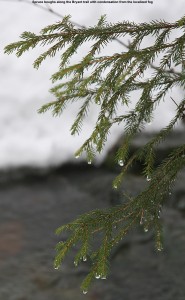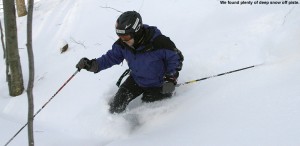
Dave had heeded my late week alert about the good skiing, so yesterday evening we worked out a Sunday morning Timberline meeting. The clipper system that had started up midday yesterday dropped roughly 4 inches of new snow at the house by 6:00 A.M. this morning, with most of that coming in at 3.7 to 3.8% H2O according to my analyses. What it meant for the local mountains was more fluff on top of fluff, so the powder skiing just continued to get deeper. Dylan had a midday birthday party (shouldn’t there be a Vermont state law mandating only evening birthday parties during ski season?), and E was taking him to that, leaving just Ty and I to join up with Dave. On the upside it meant that Dave and I could really run Ty ragged as we marauded our way through Bolton’s powder stashes… and apparently run him ragged we did.
Bolton had only reported 3 inches of new snow in the morning, but based on what we got at the house, combined with what we found on the hill, I think it was a bit underreported. Conservative snow reports are generally appreciated though. While we waited for Dave to arrive at the mountain, we took a warm up run on Spell Binder, and I found 6 to 8 inches of snow on much of the trail. Ty really ripped it up on there and he was off to a great start. Continue on with all the powdery pictures and text at the full report from Bolton Valley today.















